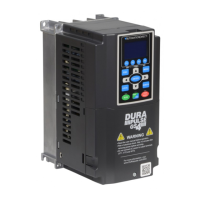Chapter 4: AC Drive Parameters
Page 4–53
DURApulse GS4 AC Drive User Manual – 1st Ed, Rev A - 10/20/2017
Type Hex Addr Dec Addr
P2.10 PWM Carrier Frequency
R/W 020A 40523
Range/Units (Format: 16-bit unsigned) Default
2~15 kHz
model specific;
refer to table below
model-specific pwm carrier frequeNcy defaults
230v/3Ø drive
supplied 3Ø/230v
variable torque
supplied 3Ø/230v
coNstaNt torque
supplied 1Ø/230v
coNstaNt torque
frame model gs4-
A 21P0, 22P0, 23P0, 25P0
8kHz
2kHz 12 kHz
B 27P5, 2010, 2015
C
2020, 2025
2030
6kHz
D 2040, 2050
E 2060, 2075, 2100 4kHz
460v/3Ø drive
supplied 3Ø/460v
variable torque
supplied 3Ø/460v
coNstaNt torque
N/a
frame model gs4-
A 41P0, 42P0, 43P0, 45P0, 47P5
8kHz
2kHz n/a
B 4010, 4015, 4020
C 4025, 4030, 4040
6kHz
D0 4050, 4060
D
4075
4100
4kHz
E 4125, 4150
F 4175, 4200
G 4250, 4300
This parameter determines the PWM carrier frequency of the GS4 drive.
•
When carrier frequency is higher than the factory setting, reference parameter P6�33 Drive
Derating Method for frequency derating of the GS4 drive�
•
When P6�34 (VT/CT Duty Selection) is set, it can change this parameter (P2�10)�
•
P6�00/P6�02 (Electronic Thermal O/L Relay) must be set independently�
As shown in the diagram below, the PWM carrier frequency has a significant influence on
electromagnetic noise, GS4 drive heat dissipation, and motor acoustic noise. Therefore, if
surrounding ambient noise is greater than motor noise, then lowering the carrier frequency will
help to reduce temperature rise in the motor. Although motor noise is reduced at the higher
carrier frequencies, the entire wiring and interference resistance should be considered before
choosing a higher frequency.
1kHz
8kHz
15kHz
Carrier
Frequency
Acoustic
Noise
Noise or Leakage
Current
Heat
Dissipation
Current
Wave
Significant
MinimalMinimal

